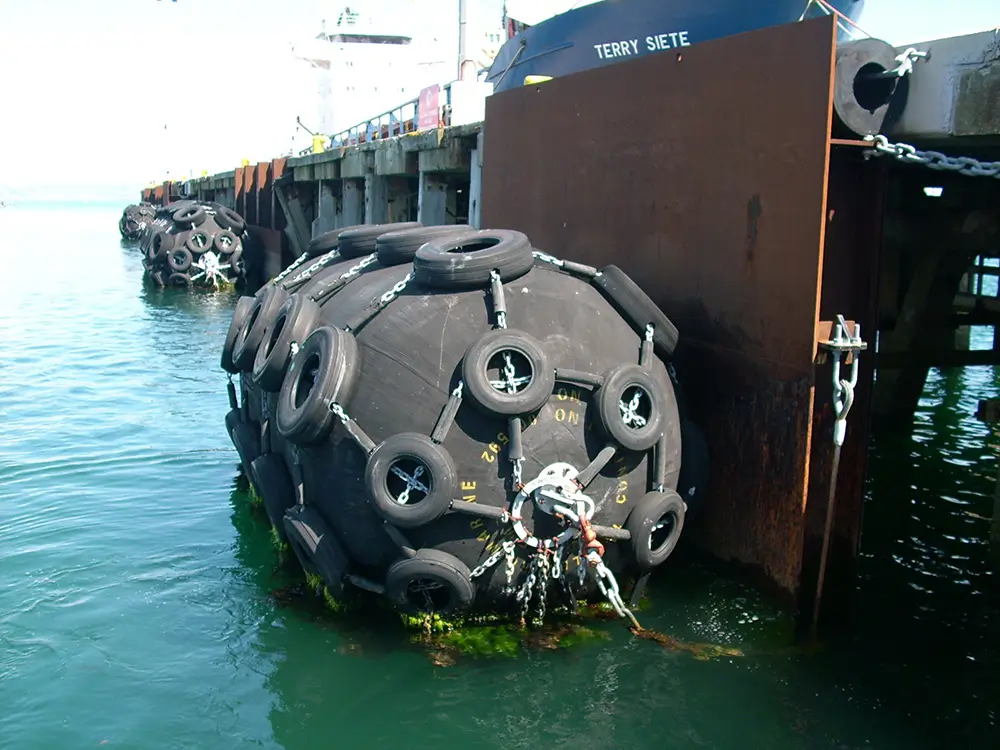The Role of Marine Rubber Fenders in International Maritime Safety
10/01/2025Ship Launching Airbags for Sale
10/03/2025Pneumatic Fenders for LNG Ships and New-Energy Vessels — simple, strong protection
LNG carriers and new-energy ships bring modern fuel systems, sensitive hulls, and tight operational rules. You — shipowners, port designers, and port operators — need fenders that protect vessels and speed up safe berthing. Pneumatic fenders deliver low reaction force, big energy absorption, and gentle contact. They keep delicate ship structures safe and lower repair costs.

Why LNG ships need pneumatic fender
- Protect thin or sensitive hulls. LNG carriers often use membrane tanks or special coatings. Pneumatic fenders give a soft, wide contact that cuts local pressure and avoids dents.
- Lower reaction force. When a ship moves into a berth, the fender pushes back gently. That reduces stress on the ship’s structure and on the quay.
- Work well in motion. Pneumatic fenders handle roll, pitch, and heave. They keep contact stable during slow transfers and during transfer operations.
- Good for STS and terminal work. For ship-to-ship LNG transfers and terminal berthing, the fender’s cushioning lowers the chance of hull damage and leaks.
Why new-energy vessels (LNG-fuelled, battery, hybrid, etc.) benefit
- New designs deserve gentle handling. Many eco-friendly ships use new hull shapes or sensitive equipment near the hull. Pneumatic fenders protect those areas.
- Flexible for mixed fleets. Ports may handle old and new ships. Pneumatic fenders adapt to different hull lines and sizes without custom parts.
- Support safe operations. New-energy systems can need precise alignment for fueling or charging. Stable, low-shock fenders make those operations safer.
Advantages over other fender types
- Higher energy absorption per size than many rigid fenders.
- Lower reaction force at the same energy level — kinder to hulls and quays.
- Self-centering and conforming contact reduces point loads.
- Easy replacement and repair — many parts serviceable on site.
- Good in heavy weather — they work well across tide and wave ranges.
Compared to solid rubber or foam fenders, pneumatic rubber fenders give a softer touch and better energy handling for large, sensitive ships like LNG carriers.
When to pick floating pneumatic rubber fenders
Choose floating pneumatic rubber fenders when you need:
- Ship-to-ship transfer protection.
- A fender that rides with waves and stays in contact.
- A solution that works for vessels with high freeboard and for the transferring hose or ladder operations.
They float and follow the vessel, keeping the contact area cushioned even as the ships move.
Installation and upkeep — simple points
- Fit fenders with proper mooring bridles and chafe protection.
- Keep them inflated to recommended pressure. Check pressure before operations.
- Inspect valves, chains, and rubber for cuts or abrasion. Replace wear parts fast.
- Use repair kits for small damages; plan scheduled replacements for heavy-use units.
Good maintenance keeps fender performance high and cost of ownership down.
Safety, cost and ROI
A fender that prevents a single hull dent or damaged tank will often pay for itself. Pneumatic fenders minimize repair bills, reduce downtime, and cut insurance headaches. They also help you meet safety rules and protect crew during transfers. For LNG and new-energy fleets, that protection matters a lot.
Short FAQ
Q: Are pneumatic fenders safe for LNG operations?
A: Yes. They lower local hull pressure and reduce shock. That helps protect tanks and gas systems during berthing and STS.
Q: How long do they last?
A: With regular checks and simple care, they last many years. Replace worn components and keep pressure correct.
Q: Can ports retrofit them easily?
A: Yes. You can mount pneumatic fenders on quays or use them for STS buoys and barges. They fit many setups.
Q: Do they work in rough weather?
A: They perform well across tides and in moving water. Use correct mooring and spacing for best results.
Final note — protect value, reduce risk
If you handle LNG ships or new-energy vessels, choose fenders that protect delicate systems and reduce repair risk. Pneumatic fenders and pneumatic rubber fenders, including floating pneumatic rubber fenders, give proven cushioning, low reaction forces, and flexible use. They cut damage, keep operations smooth, and save money long term.
